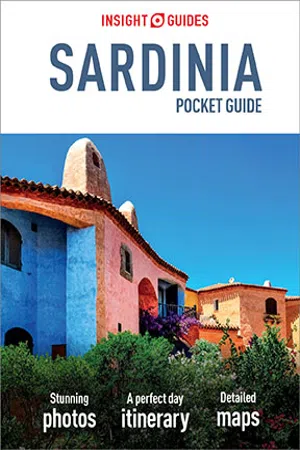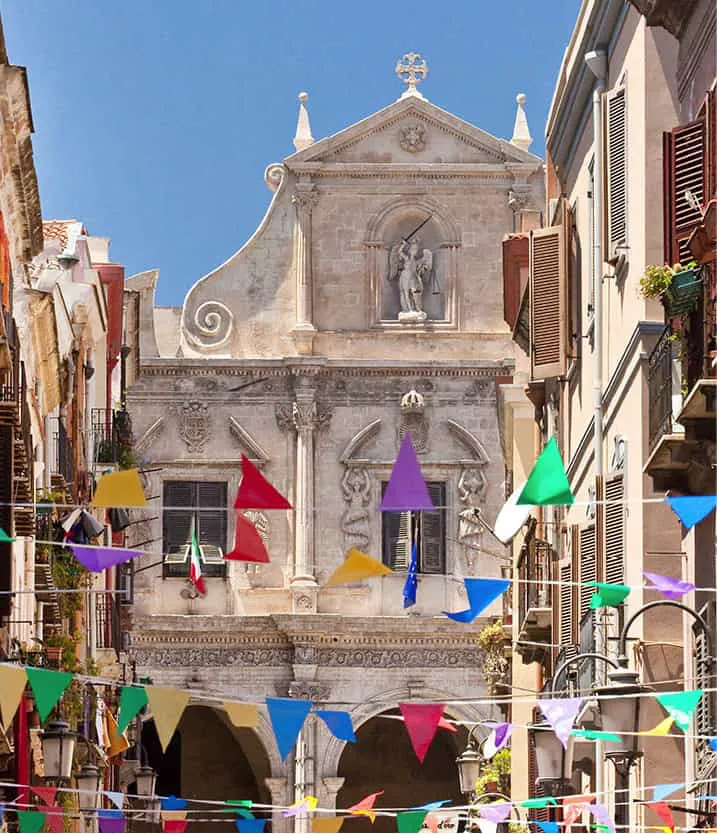Getting Around
The island is too large to explore from a single base. If touring, two weeks would be just adequate to sample the different aspects of the coast and the sightseeing highlights, but to see the island comfortably you would need a month. If time is limited to a week or less, make your base in one of the main regions, taking day trips to the coast or forays inland to remote rural areas. The provincial capitals of Cagliari and Sassari are well worth visiting but are not ideal as tourist bases.
Church of San Michele, Cagliari
iStock
Cagliari and the Southeast
Cagliari
Capital of the island and its main port, Cagliari 1 [map] is the most cosmopolitan and modern of Sardinia’s cities. Industrial outskirts and traffic-choked streets can be intimidating, but the heart of the old city retains plenty of picturesque charm and historical interest. Along with churches, monuments and museums the city provides the best choice of restaurants and shops on the island and, to the east, a huge sandy beach and flamingo-filled lagoon.
‘Karalis’ as it was originally named, was one of several settlements in southern Sardinia established as trading posts by the Phoenicians. By the time of Roman rule, it had become one of the main trading ports of the Mediterranean. The most striking legacy of Roman occupation is the Anfiteatro (Amphitheatre; www.beniculturalicagliari.it; May–mid-Oct Fri–Sun 9am–5pm, mid-Oct–Apr Sat–Sun 10am–7pm; guided visits) carved out of the rock on the hillside in the Stampace quarter of the city. Battles between gladiators and beasts drew audiences of 10,000; today the ruins make an evocative setting for concerts, opera and theatre. The town’s earliest example of Christian architecture is the heavily restored Basilica of San Saturnino (Tue–Sat 9am, 10am–1pm and 3.30–7.30pm, though often closed) on Piazza San Cosimo, in what is now modern Cagliari. Built to commemorate the Sardinian saint who was martyred on this spot in 303, it is a beautiful domed 5th-century cruciform church with a distinctly oriental look.
The bulwarks of Cagliari’s medieval defences were built on the hill by the Pisans, who took control in the 13th century. A ring of walls (best seen from afar) was constructed around the city, followed by two defence towers in 1305 and 1307 built in anticipation of Spanish invasions. Pisan concern was not unfounded and the Aragonese put an end to their rule in 1324. Several centuries of Iberian domination finished ingloriously in 1708 when the city yielded to a small Austro-British naval force without so much as a fight.
Castello
On top of the hill, the Pisan- and Aragonese-built Castello A [map] was the former political, religious and administrative centre. This is the oldest and most interesting quarter of the city, with its monuments, narrow alleys and picturesquely dilapidated dwellings. It is easily covered on foot, though you can hop on one of the tourist ‘trains’ that depart from Piazza Carmine for a 45-minute guided tour. By foot it’s best to start at Piazza Costituzione, then climb the monumental stairway of the Bastione San Remy B [map]. The views from the esplanade, where you can sit with a drink, encompass the city, port and lagoons. West of the bastion lies the Pisan-built Torre dell’Elefante (Elephant Tower; www.beniculturalicagliari.it; closed for renovation at the time of writing). The name derives from the little carved elephant which you can see on a plinth on the Via Università side. The tower took on a grisly role under Spanish rule when the severed heads of prisoners were hung in cages above the portcullis. You can admire the views from the tower (when it reopens) or those from the terrace of the nearby Caffè Libarium Nostrum (Via Santa Croce) on the city walls.
Cattedrale di Cagliari
Sylvaine Poitau/Apa Publications
To the east, Piazza Palazzo is flanked by 18th-century buildings and, in one corner, by the striking Cattedrale di Cagliari C [map] (www.duomodicagliari.it; Mon–Fri 8am–12pm, 4–8pm, Sat–Sun and holidays 8am–1pm, 4.30–8.30pm). This Pisan Romanesque church was rebuilt in the 17th century and given a mock Romanesque facade in 1938. The multicoloured interior is essentially Baroque but retains marble gems from the original church: the 12th-century pulpits on the entrance wall, exquisitely carved with reliefs illustrating The Life of Christ, and, in front of the altar, the four lions, each with their prey. The elaborate crypt (entered via a doorway behind the far-right lion) houses the tombs of the Savoy royal family. Next to the cathedral is the much rehashed Archbishop’s Palace, and beside it the Palazzo Viceregio, built by the Aragonese for their viceroys. Today it is home to the provincial assembly and occasionally opens to the public for exhibitions.
At the far end of the Piazza, the Torre di San Pancrazio (San Pancrazio Tower; same hours as Torre dell’Elefante) was built at the highest point of the city to keep guard over vessels sailing through the Gulf of Cagliari. The Aragonese used it as a storehouse and lodging for government officials, and from 1600 it became a prison.
Citadella dei Musei
At the northern end of Castello, the Citadella dei Musei D [map] (Citadel of Museums) is an imaginative cultural centre of gardens and modern museums, incorporating the remains of the Spanish Royal Arsenal. If you choose to visit just one museum make it the Museo Archeologico Nazionale E [map] (National Museum of Archaeology; www.museoarcheocagliari.beniculturali.it; Wed–Mon 9am–7.30pm), housing treasures from major sites throughout the island. Arranged on four floors, the collection provides an overview of successive cultures from Neolithic to early medieval. The upper floors are arranged topographically, focusing on the main Nuragic and Roman sites in the Cagliari province. A combined ticket gives you entry to the Pinacoteca Nazionale (National Art Gallery; www.pinacoteca.cagliari.beniculturali.it; Tue–Sun 8.15am–9.15pm) whose most interesting works are the Quattrocento and Cinquecento altarpieces, many of them Catalan.
The Phoenican, Roman and Byzantine periods are all well represented at the Archaeological Museum, but the prize pieces are the Nuragic bronzetti, exquisite and often humorous statuettes of humans and animals which would not look out of place in a stylish modern art gallery.
Roman Emperor at Museo Archeologico Nazionale
Sylvaine Poitau/Apa Publications
On an entirely different theme, the nearby Museo d’Arte Siamese Stefano Cardu (Cardu Museum of Siamese Art; www.museicivicicagliari.it; Tue–Sun mid-June–mid-Sept 10am–8pm, mid–Sept–mid-June 10am–6pm) is a collection of oriental porcelain, weapons and precious objets d’art bequeathed to the city in 1917 by Stefano Cardu. A contractor of public works, credited with the construction of the Royal Palace in Bangkok, Cordu was a Sardinian who lived in Siam (modern-day Thailand) for 20 years, making his fortune and amassing his treasures.
A bizarre collection of anatomical wax models, including macabre cutaway heads and stomachs, is displayed in the Museo delle Cere Anatomiche di Clemente Susini (Clemente Susini Museum of Anatomical Waxwork; http://pacs.unica.it/cere; Tue–Sun 9am–1pm and 4–7pm) near the entrance to the Citadella. This unlikely collection was commissioned in 1801 by Carlo Felice, the viceroy of Sardinia.
Marina and Stampace
In the lower town, below Castello, Marina is a busy quarter of shops and restaurants. A favourite spot for a stroll or drink is Via Roma, whose dignified arcades shelter traditional cafés and elegant boutiques. The street runs paralle...




